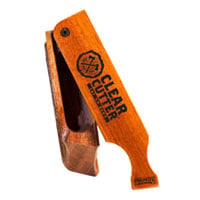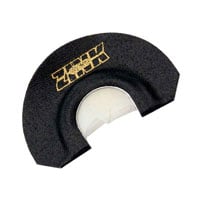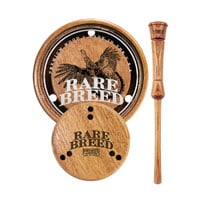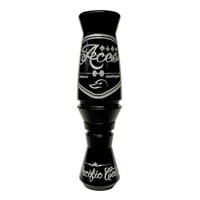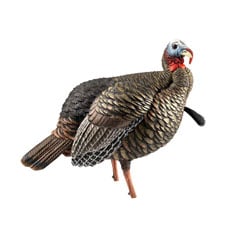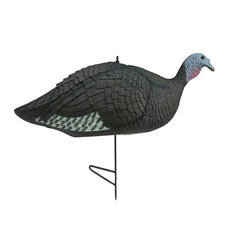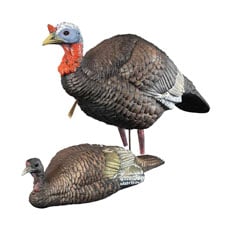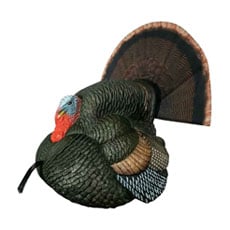Hunting turkeys is one of the most exciting, and most frustrating things you will ever do. These birds are a ton of fun to hunt, but they definitely pose a challenge. If you have never turkey hunted before, don’t expect to waltz into the woods and get one immediately. Only about a third of turkey hunters are successful each year. Besting one of these smart birds takes patience, a fair amount of skill, and plenty of luck.
While I can’t help you with luck or patience, I can do my best to improve your skill today. We are going to go over all the basic information you need to know to bag a turkey this year. There is plenty to talk about, so let’s get started with most hunters favorite hunting topic, the gear.
- Basic Gear
- Turkey Seasons & Licenses
- Scouting For Turkeys
- Calling Turkeys
- Making a Set
- Shot Placement & Retrieval
- Bringing it All Together
Basic Turkey Hunting Gear
Hunting gear is a unique area of the hunting industry. The truth is that your gear can be as complicated and expensive as you want it to be, but 99% of the time, it isn’t going to be the difference between a successful hunt and a bust. The one exception may be clothing, you definitely want quality clothes to stay warm and comfortable on a hunt. Just don’t feel like you have to have one of everything on the turkey hunting shelf, or the most expensive piece of gear before you head out to the woods.
Your Shotgun & Ammo
If you are just getting started turkey hunting, you should probably use a shotgun. While you can hunt turkeys with archery equipment, it is even harder than regular turkey hunting, so I wouldn’t suggest it for a beginner. The weapon of choice for the vast majority of turkey hunters, including myself, is a 12 gauge shotgun.
While just about any shotgun will work, you can find purpose made turkey shotguns between $500 and $1500. To save a bit of cash, you could pick up my all time favorite shotgun, the Remington 870 for less than $500; there is even a turkey hunting model. If you aren’t quite sure what kind of shotgun you want, I recommend getting something that is on this list of turkey shotguns.
The next thing you will need to pick out is a choke for your shotgun. The purpose of a choke is to “choke” down the shot as it comes out of the end of the barrel. A choke makes the end of your barrel just marginally more narrow than the barrel itself. This keeps your shot in a tighter group, and increases your maximum range, which is important for skittish turkeys.
There are likely thousands of articles and probably a few books about which choke is best for turkey hunting, and no matter which one you pick, someone online will tell you that you picked wrong. So if you don’t know much about chokes as a beginner turkey hunter, take my word for it that a full choke is a good place to start.
The one thing more controversial than turkey chokes is picking out turkey hunting shotgun shells. Your ammo choice is important, and there is plenty of strategy that goes into it. You can get lead, steel, tungsten, or alloy shot. You can also get shot of various sizes, usually from 4 shot up to 9 shot for turkeys, or a mixture of multiple size shots. Tungsten Super Shot (TSS) is usually considered the best type of shot, but can cost over $10 a shell, and you can get standard lead shot for around a dollar a shell. If you don’t want to bother with all that research, any shell in this list is a good bet:
Once you pick a shotgun, choke, and ammo combination, you need to pattern your shotgun. You will see this on just about every turkey hunting article out there that mentions shotguns, and that says just how important it is. Patterning your shotgun just means shooting a few targets and seeing how your shot performs. It will also help you see what your maximum range is, and get you used to shooting those stout turkey shells. You want a healthy portion of your pellets to be on the bullseye, a few pellets in the kill zone isn’t going to cut it.
I suggest picking up some turkey paper targets, and shooting at 10, 20, 30, 40, 50, and 60 yards. You will see how your shot spreads out and there won’t be any surprises when the target is a real turkey. If you aren’t happy with your pattern, you can try a different choke. If you started with the full choke, you can go up to a modified choke to get a wider pattern, or a super full choke for an even tighter pattern. Although you should always triple check your shot choice can go through your choke, which should be labeled on the choke or its packaging.
Good Camouflage
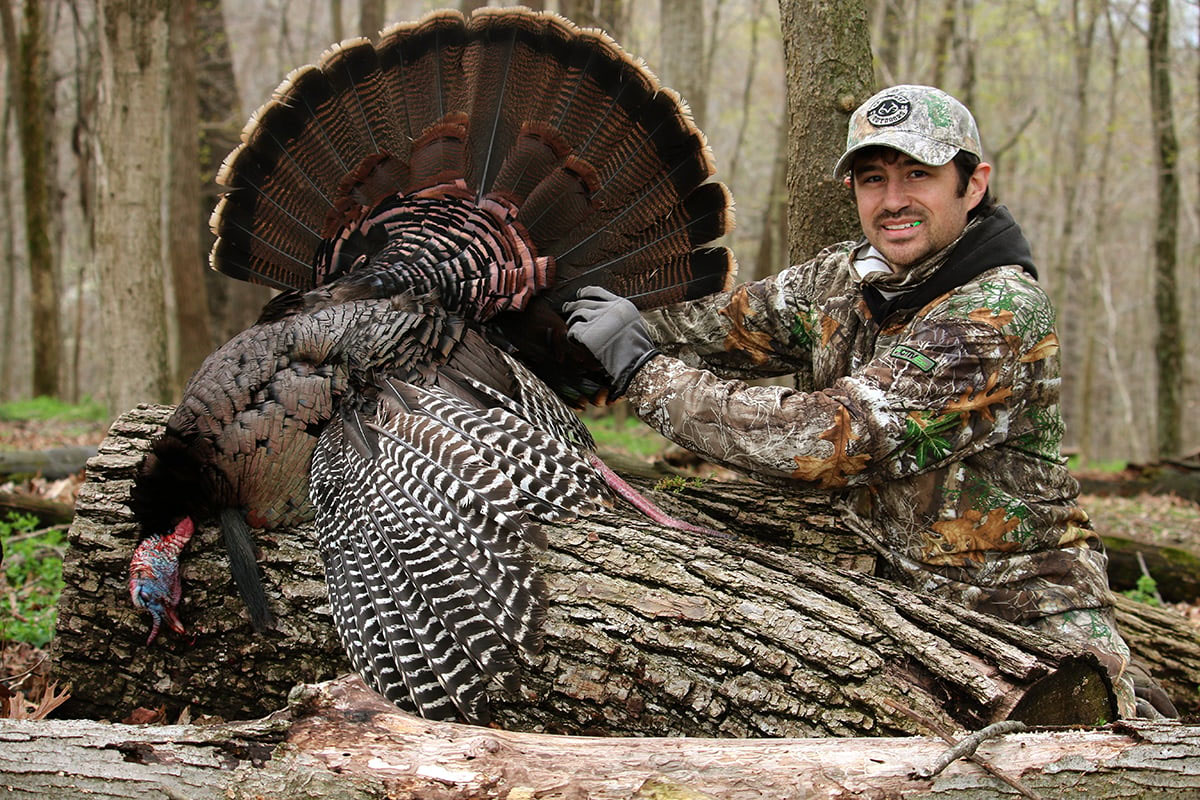
One of the first things that you will learn about turkeys, likely the hard way, is that they have very good eyesight. So you are going to want to wear some good camouflage. Notice I didn’t say expensive camouflage. I recommend getting a basic realtree or mossy oak pattern shirt and pant combo and calling it good. There is no need to spend hundreds on your camo. Just make sure you also wear gloves and a facemask. Any bit of skin showing is like a beacon to turkeys.
I should also mention that your movement is 100 times more important than the camo pattern you choose. Turkeys are especially good at picking up movement, and any little movement that is out of place during the wrong time will certainly send a tom the other way.
Turkey Hunting Vest & Pack
The next thing you will want is a turkey hunting vest. This is really just a vest with plenty of pockets that often has a seat attached to it. It is designed to let you quickly and comfortably sit down, and keep all of your most important gear close and available. Most of these vests also function as a backpack, so you can keep all your gear in a single bag.
One of the best turkey hunting vests on the market, and the most popular one on Sportsmans Warehouse, is the Nomad Killin' Time Turkey Hunting Vest, and I would recommend it to any beginner or experienced turkey hunter.
Turkey Calls
Turkey calls are a giant part of the turkey hunting industry. There are entire turkey calling competitions that thousands of hunters attend each year, and I am sure there is a unique call on the market for every one of them. There are thousands of calls out there, and plenty of custom calls too. For a beginner, you don’t need to worry about being the best turkey caller ever, if you can get a basic yelp down and string a few of them together, you can kill turkeys.
As far as the type of call you should get, there are plenty of options there too. The most popular, and the cheapest, is the diaphragm call. This is a small call that goes in your mouth. You use it by blowing air through a small reed like piece of rubber, but it is going to take a bit of practice. Although after a single evening of annoying the hell out of my roommates when I got my first diaphragm call, I was able to make a pretty good yelp and you can too.
The next call you might want to pick up is a slate call. This thing has plenty of names, like slate, pot, or pot & peg, but they are all the same. A pot call can be made with slate, or glass, and you use a striker to scratch the surface and make a sound that resembles a turkey. The striker is usually made of wood, but can also be made of graphite, plastic, or a number of other materials. These calls are pretty easy to use and sound pretty good. You can get slightly different sounds with different materials, and some hunters even use different strikers on the same pot to make different noises.
The last turkey call that I will mention here is the box call. This call consists of a rectangular wooden box with a lid that is attached to a paddle. To use the box call, all you have to do is rub the paddle across the top of the box. You can vary the tone and volume of the call by adjusting the pressure and speed of the paddle's movements. One advantage of the box call is that it can produce a wide range of turkey vocalizations, making it a versatile tool for beginners, plus it is fairly easy to use.
There is one more call you might want to bring, but it isn’t technically a turkey call. I’m talking about a locator call. Turkeys will instinctively gobble when they hear a loud noise, we call this a shock gobble. You can use all sorts of calls to make a turkey shock gobble. A few examples are an owl call, duck call, crow call, coyote howl, woodpecker call, and even a peacock call. Although a loud clap, whoop, or a slamming truck door does the trick too. You can use this to see if any turkeys are nearby, and get a general idea of which way to go when you start your hunt.
A Few of Our Favorite Calls
Turkey Decoys
Turkey decoys are an extremely popular tool for hunters, especially in the spring when turkeys are focused on breeding. You have three general choices for decoys, a tom, jake or hen. Although you can get toms and jakes in quarter, half, or full strut. You can also get hens with their heads up, down feeding, or in a breeding position. There is plenty of strategy that goes into picking the perfect decoy combination, but here are a few solid strategies for the different parts of the season.
During the early season toms are going to be super aggressive. This is when you want to use a full strut gobbler, and you can mix in a hen or two while you’re at it. Any self respecting tom that sees that decoys is going to feel challenged and start rushing in, or circling. Either way, you will get a good chance at a shot. It is a good idea to place your decoy in a popular food source that hens frequent, that's where the toms will be looking.
In the mid season you want to use a hen or two with a half strut jake. This will bring in most male turkeys throughout the spring. During the mid season toms are looking to breed the hens that are yet to be bred and they are willing to fight for it. Toms will be more comfortable running off a submissive looking jake than challenging a bigger tom. You can also use a laydown hen to get even more action, just make sure it is visible.
During the late season you can use a hen or two to get a good response from toms looking to close the deal with the last hens of the year. A feeder and upright hen are a good combo to go with, but don’t use much more than two hens. During this time of year, turkeys are fairly broken up and are focusing on feeding, and you want to match that with your decoy setups.
A Few of Our Favorite Decoys
Basic Hunting Gear
The last pieces of gear that I thought I should mention are the same pieces of gear that you would need to hunt just about anything. Things like a knife, or a headlamp are just a given when you are in the woods, but if you forget them, you could cut your trip short. Here is a quick list of what you won’t want to forget on your next hunt. Just remember that when you are out on a hunt that isn’t particularly close to home, 2 is 1 and 1 is none when you are packing gear.
- Headlamp or handheld flashlight, and a backup
- Utility knife
- Small bundle of paracord
- Appropriate clothing, and rain gear if needed.
- Snacks & Water
- First Aid kit
- Battery bank for your phone
- Handheld GPS or GPS app
Turkey Seasons & Licenses
Usually when we are talking about turkey hunting, we are talking about the spring season. This is when turkeys are focused on breeding, and it is when you are likely to see the most action. Hunters are usually allowed to kill 2 to 3 male turkeys during the spring based on their state, and you are not allowed to shoot hens during this season.
Although there is a season during the fall in many states where you can take a few hens, and a tom or jake. Many states have beard restrictions during this season, influencing hunters to take jakes, and some states have restrictions on how many turkeys you can take in a single day. So make sure to read your state's regulations thoroughly, but if you just want to bag a legal bird, the fall is a great time to do it.
While every single state except for Alaska (which doesn’t have turkeys) has a spring season, only 42 states have a fall season. Unfortunately for me, Georgia isn’t on that list. Neither is Alaska, Arkansas, Delaware, Louisiana, Nevada, North Carolina, or South Carolina.
No matter what state you are hunting in, make sure you know the regulations like the back of your hand before you start shooting. You want to do everything legally, and the regulations in place are a part of the management strategy of the state. Plus, illegal turkeys carry a hefty fine. So buy a license and read the regulations!
Scouting for Turkeys
In the fall, turkey's food sources will depend on what part of the country you are in. In general, turkeys like eating crops such as corn, nuts (i.e. acorns), or even conifer needles and buds. Because there is such a wide variety of food sources that turkeys may be eating in your area, you’ve gotta scout to figure out where and what the turkeys are feeding on.
When scouting, search for areas that are torn up. Turkeys aren’t delicate feeders and if you come across an area where turkeys have been feeding recently then you will see small piles of leaves, scratches in the visible dirt, overturned leaves and sticks, and scat. Because turkeys are “flocked up” in the fall, the areas where they are feeding may be quite large. I’ve seen torn-up areas where turkeys have been feeding ranging from 5 yards to 30 yards in diameter.
Don’t stop scouting once you find one area where they are feeding. Once you find where the turkeys are feeding, you can hone in on what they are feeding on. Keep searching and mark each area you find with a GPS or a phone mappings program. After you learn what the turkeys are feeding on, mark additional areas where the same forage is present, even if the turkeys haven’t been there yet.
Once you find enough areas where the turkeys have been feeding and might start feeding you will be able to create a good game plan to harvest the birds. You may also be able to figure out roughly how the turkeys are moving throughout the day. Although when the season is in full swing and turkeys are all over the place, your scouting will not matter as much. You just have to do your best to locate some birds and start working them.
The last thing to look for is the roost site. Turkeys are typically very talkative in the fall when they are on their roost. If you can, listen around sunrise or dusk in an area where you know birds are at. If you’re close, you will hear them. Once you know where their roosting site is, that is a great way to reliably find birds to work day after day.
Calling Turkeys
We talked a bit about different turkey calls earlier, but now I want to talk about how to use them. We talked about the physical types of calls, but you can use those to make dozens of different calls or sounds that a turkey would make. For someone just starting out, I don’t suggest you try to learn and use every type of call a turkey makes.
You can get by with just making three different calls; the yelp, fly down cackle, and the purr. The yelp is a short series of cackles and it is the most basic turkey call. The fly down cackle is the sound a hen makes when, you guessed, she flies down from the roost. It sounds more or less like a really fast string of yelps, and it lets toms in the area know that she is down from the tree and the game has begun. The purr is a soft and low sound that turkeys make when they are feeding, and it lets other turkeys know that all is good over here.
There are an infinite amount of scenarios you could encounter in the woods, and as you mature as a turkey hunter, you will know when to use which calls. Although for the sake of time, I am going to go over a basic situation and show you which calls to use and how.
Let’s say, you did some scouting and you know an area that has a few turkeys. You get there early in the morning before the sun comes up and you find a good place to sit and wait. You want to wait quietly, don’t be too excited to use those calls. If you scouted right, you should start to hear some turkey activity as the sun comes up, especially if you found a roosting area.
When it starts to get light out, you can let out a few soft yelps. This is what hens do in the morning before they fly down, and it just lets turkeys know you are in the area. If you can hear other turkeys in the roost, match what they do. If not, make your calls and wait a little while.
Once you can see clearly, you will want to make your fly down cackle. This tells toms that a hen just flew down and that it is time to get the day started. After waiting a while, if you haven’t heard any turkey activity, you should start to move on and try to locate some birds. Although if you have heard turkeys, you want to match their energy. If they are calling a lot, you can too. If they call every now and then, you should too.
The key is that you listen to the turkeys around you and act like they do. Most of the time, less is more, and silence can be the best call. If you manage to find a gobbling tom, match his energy. If he is fired up, you can be too. Just make sure to listen more than you call, if he starts coming your way, you need to set up and be ready for the shot. Many a turkey hunt has been ruined by a quick tom busting the caller before they even know he’s there.
Making a Set
Once you have found some birds and get a gobbler or two going, the action starts. This is a learned skill, but you have got to listen to not only if the bird gobbles, but where they gobble from, and how that relates to their last gobble. That way you can piece together how that bird is moving, and you can figure out when they are going to be within range. It helps if you know the land well, but this is an art that you will learn the hard way after being busted by early toms, and once you think you have it figured out, you’ll get busted again.
When you feel like a bird is coming your way, it is time to get ready for the shot, AKA make a set. This assumes that you are not hunting from a stationary point like a blind, and that you are moving around the woods looking for turkeys. If you are carrying decoys, this is when you quickly put them out, and find a good place to hide. How many or which decoys you use is another strategy in and of itself, and we talked about it briefly in the prior decoy section.
You want to put your decoys roughly 10 to 15 yards away from you so that if the bird doesn’t come right up to them, which is common, then he will still be in range. Although plenty of hunters don’t use decoys all the time, and they certainly are not required to kill turkeys.
Next, you need to find a place to sit. This is usually going to be up against a tree, but the more cover you can get, the better. You will want to set up with your gun ready, because there will be no time to pull a shotgun up and get a shot, you will get busted the second your muscles twitch.
Instead, sit down with your gun propped up on your knee. If you use a mouth call, this is an awesome way to call with your mouth, and still have your hands ready to shoot when a tom comes in. Although if you are using a slate, which plenty of hunters prefer, you can hide it behind your legs and conceal your movement.
You have to be quick when making a set, so if you sit down and are fairly exposed, point your shotgun where you think the tom is most likely to come from. The perfect set is one where he comes right in and you pull the trigger without having to move at all; but as we all know, it doesn’t always happen like that. The most important part of your set is your movement. If a long beard is coming your way, he is going to be looking for a hen, and if you move the wrong way, he's going to notice.
No matter how good of a hunter you are, a set doesn’t always work, or a gobbler might not come in at all. Making a good set comes with practice, and failure. If you spook the tom you are after, he might come back, but it is more likely that he is gone for the day. Although your hunt isn’t over, he isn’t the only turkey in those woods.
Shot Placement & Retrieval
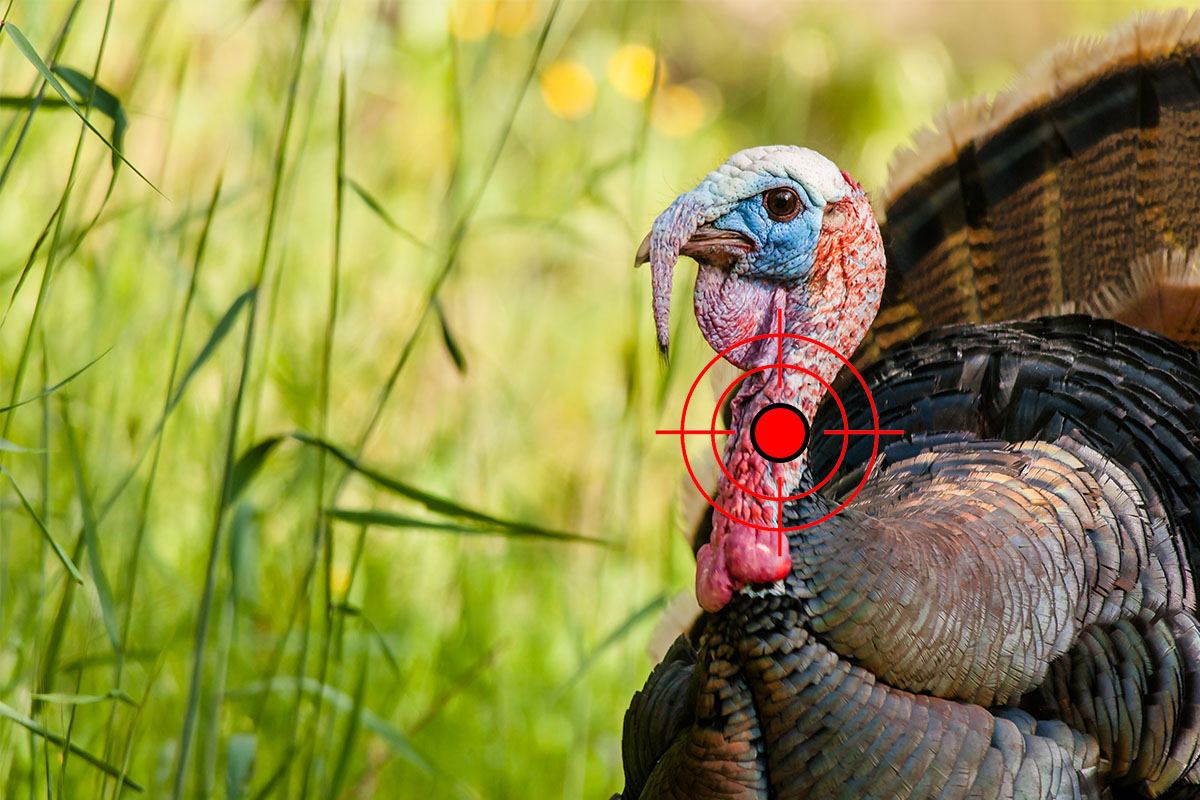
If you patterned your shotgun like I suggested in the gear section, now that you have made a set and called in a tom, you should be ready to put him down. You want to aim for the head with a shotgun, so you will want to let the tom stick his head up before taking the shot. This is important when you have your bead on a strutting tom. You can shoot while he is strutting, but it is easier if you hit him while his head is up.
Once you make a good shot, and he is flopping on the ground, you need to run after him. This is a bit counter intuitive from other types of hunting, and you certainly wouldn’t do this with something like a deer or an elk, but turkeys are a bit easier to handle. A wounded turkey can take off running after he gets his wits back, so you will want to grab him before that happens. If you thought he was hard to find the first time, the second time will be much worse.
If you get your hands on your turkey and you made a good shot, you don’t need to worry too much about their movement, they are dying, it just takes time. If they are moving a lot and you aren’t quite sure if you made a lethal shot, you can stand on their neck for a while until they stop moving. It is a bit ugly, but that is life, and death was the goal. Nonetheless, when you have got hands on a turkey, that is a success and it is time to celebrate!
Bringing it All Together
Man that was a lot wasn’t it? No one said turkey hunting was easy, and to be honest, we only scratched the surface of our slate calls today. There is plenty of nuance and strategy around turkey hunting, but with everything we have talked about today, you have the bare bones and you can certainly kill turkeys with enough patience.
As with any kind of hunting, you need to make sure you have your gear in order, and know the hunting regulations for your area. When turkey season gets here, you will be happy that you did plenty of scouting beforehand. Calling will take some time to get good at, but you can do plenty of damage with just a few basic calls. When you think a tom is closing in, make your sets quickly and spend more time listening than calling. When you get the chance, take a breath and make a good shot.
All and all, turkey hunting is exhilarating, and all the work you put in will be worth it the second you hold that bird in your hands. Good luck, and don’t be discouraged when (not if) the hunt doesn’t work out. They call it hunting and not killing for a reason!
